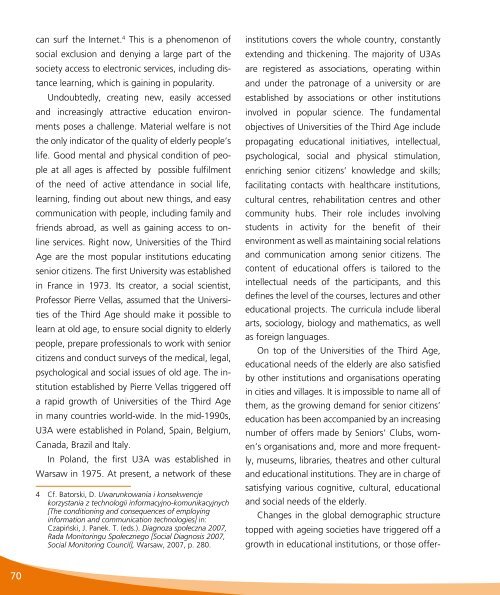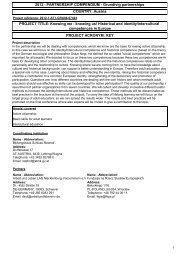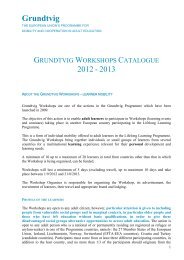Pobierz plik - Grundtvig
Pobierz plik - Grundtvig
Pobierz plik - Grundtvig
Create successful ePaper yourself
Turn your PDF publications into a flip-book with our unique Google optimized e-Paper software.
can surf the Internet. 4 This is a phenomenon of<br />
social exclusion and denying a large part of the<br />
society access to electronic services, including distance<br />
learning, which is gaining in popularity.<br />
Undoubtedly, creating new, easily accessed<br />
and increasingly attractive education environments<br />
poses a challenge. Material welfare is not<br />
the only indicator of the quality of elderly people’s<br />
life. Good mental and physical condition of people<br />
at all ages is affected by possible fulfilment<br />
of the need of active attendance in social life,<br />
learning, finding out about new things, and easy<br />
communication with people, including family and<br />
friends abroad, as well as gaining access to online<br />
services. Right now, Universities of the Third<br />
Age are the most popular institutions educating<br />
senior citizens. The first University was established<br />
in France in 1973. Its creator, a social scientist,<br />
Professor Pierre Vellas, assumed that the Universities<br />
of the Third Age should make it possible to<br />
learn at old age, to ensure social dignity to elderly<br />
people, prepare professionals to work with senior<br />
citizens and conduct surveys of the medical, legal,<br />
psychological and social issues of old age. The institution<br />
established by Pierre Vellas triggered off<br />
a rapid growth of Universities of the Third Age<br />
in many countries world-wide. In the mid-1990s,<br />
U3A were established in Poland, Spain, Belgium,<br />
Canada, Brazil and Italy.<br />
In Poland, the first U3A was established in<br />
Warsaw in 1975. At present, a network of these<br />
4 Cf. Batorski, D. Uwarunkowania i konsekwencje<br />
korzystania z technologii informacyjno-komunikacyjnych<br />
[The conditioning and consequences of employing<br />
information and communication technologies] in:<br />
Czapiński, J. Panek. T. (eds.). Diagnoza społeczna 2007,<br />
Rada Monitoringu Społecznego [Social Diagnosis 2007,<br />
Social Monitoring Council], Warsaw, 2007, p. 280.<br />
institutions covers the whole country, constantly<br />
extending and thickening. The majority of U3As<br />
are registered as associations, operating within<br />
and under the patronage of a university or are<br />
established by associations or other institutions<br />
involved in popular science. The fundamental<br />
objectives of Universities of the Third Age include<br />
propagating educational initiatives, intellectual,<br />
psychological, social and physical stimulation,<br />
enriching senior citizens’ knowledge and skills;<br />
facilitating contacts with healthcare institutions,<br />
cultural centres, rehabilitation centres and other<br />
community hubs. Their role includes involving<br />
students in activity for the benefit of their<br />
environment as well as maintaining social relations<br />
and communication among senior citizens. The<br />
content of educational offers is tailored to the<br />
intellectual needs of the participants, and this<br />
defines the level of the courses, lectures and other<br />
educational projects. The curricula include liberal<br />
arts, sociology, biology and mathematics, as well<br />
as foreign languages.<br />
On top of the Universities of the Third Age,<br />
educational needs of the elderly are also satisfied<br />
by other institutions and organisations operating<br />
in cities and villages. It is impossible to name all of<br />
them, as the growing demand for senior citizens’<br />
education has been accompanied by an increasing<br />
number of offers made by Seniors’ Clubs, women’s<br />
organisations and, more and more frequently,<br />
museums, libraries, theatres and other cultural<br />
and educational institutions. They are in charge of<br />
satisfying various cognitive, cultural, educational<br />
and social needs of the elderly.<br />
Changes in the global demographic structure<br />
topped with ageing societies have triggered off a<br />
growth in educational institutions, or those offer-<br />
70







